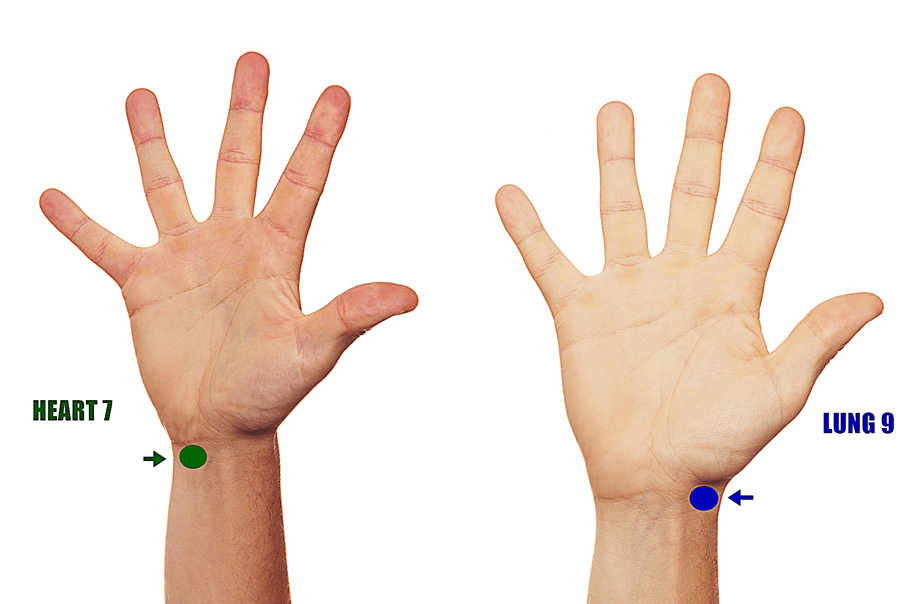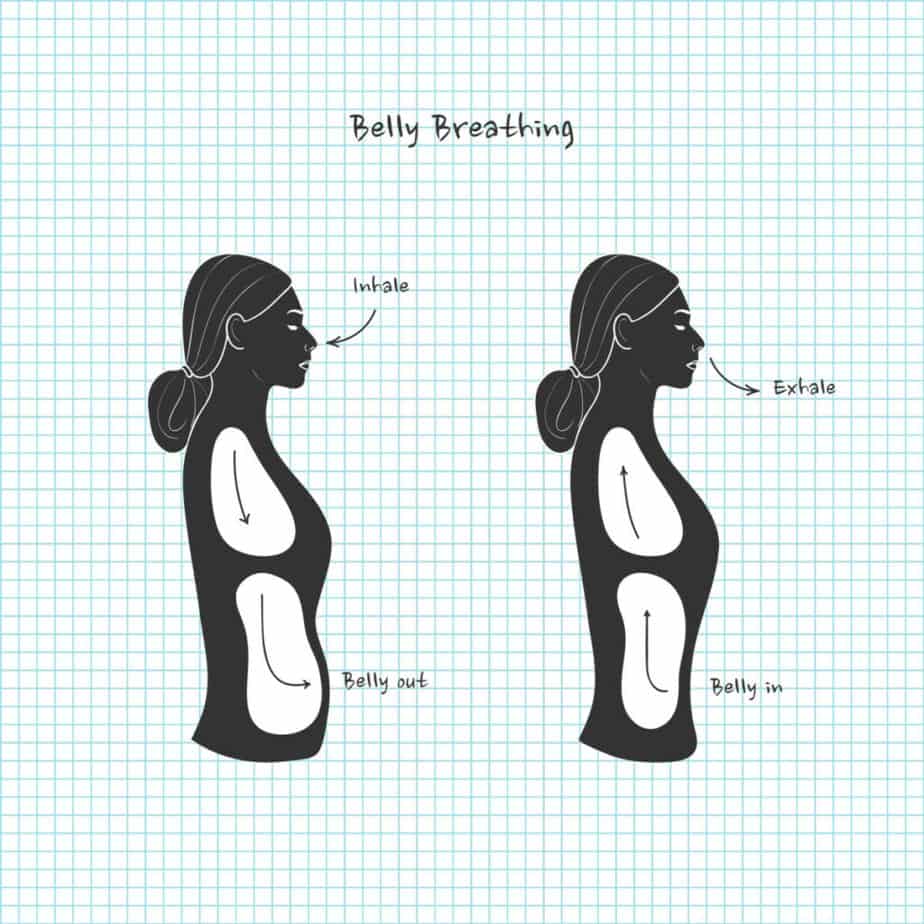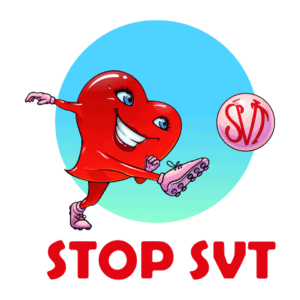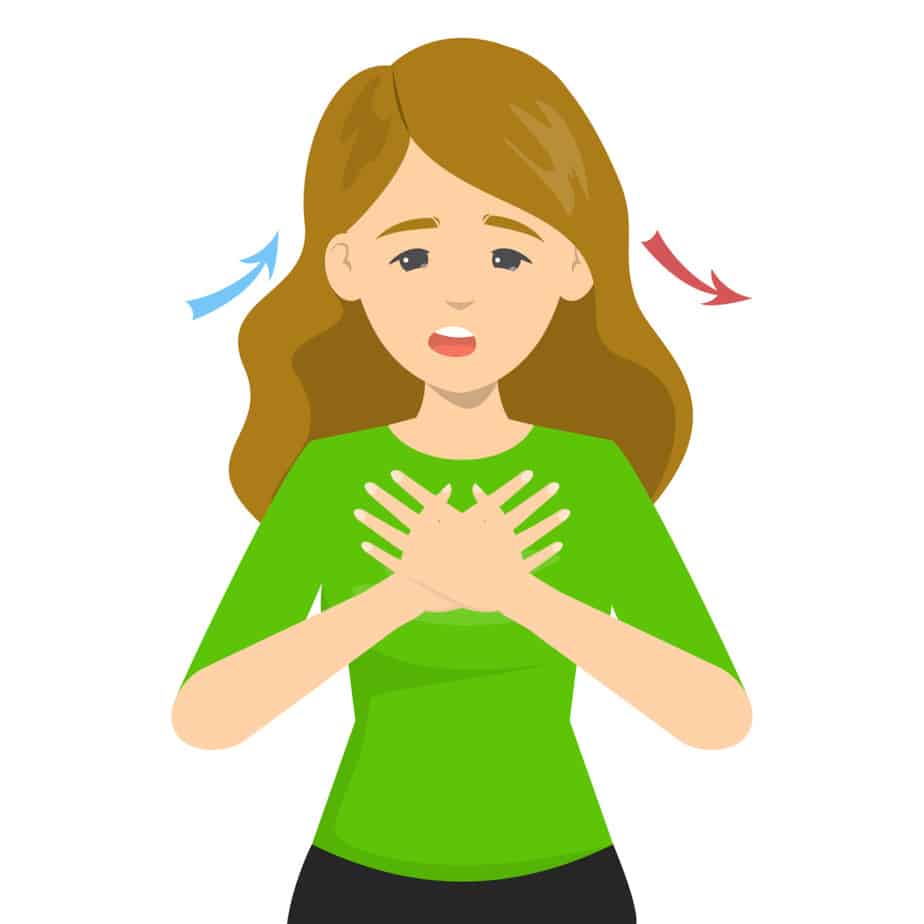You may already know that healing your SVT doesn’t happen overnight, so the first thing you have to learn is how to deal with an episode when it happens.
The good news is you CAN convert out an SVT episode most of the time using different techniques. In the context of supraventricular tachycardia, the vagal maneuver is usually done to achieve vagal nerve stimulation.
A person can terminate an episode in several ways such as bearing down, blowing in a syringe, immersing your face in cold water, performing a headstand, coughing or even gagging. Vagus nerve stimulation is one of the first-line treatment options for someone who wants to stop SVT at home. Performing Valsalva maneuver stimulates the vagus nerve and activates the parasympathetic nerves of the heart, which slows down the heart rate.
We are going to explore some of them.
Table of Contents
Valsalva maneuver or bearing down
From a standing or sitting position, pinch your nose, keep your mouth closed and ‘bear down’, which is to exhale forcibly against a closed mouth and nose, without letting any air coming out for 15 seconds.
Contract your abdomen as if you are trying to empty your bowels. You will feel the pressure building up inside your chest and stomach. It is like when you are sitting on a toilet and straining.
Blowing in a syringe
Another way to perform a Valsalva maneuver is to lay lie down with your face up and blow into the end side of a needleless syringe as hard as you can to move the plunger out slowly. Do this for 15 seconds.
The effort to blow will maximize pressure in the chest and stimulate the vagus nerve, increasing vagal tone, which, as a result, will generate a parasympathetic response lowering the heart rate.
If you get dizzy at any point, you should stop. Perform a maximum of three attempts with a two-minute minutes interval before trying the next maneuver.
Modified Valsalva maneuver
From a sitting position, you blow into a syringe as hard as you can for 10-15 seconds. Right after that, lay lie flat on your back and someone should lift your legs at 45 degrees and keep them in that position for another 15 seconds.
Lying down in a flat position will allow you to convert your supraventricular tachycardia effectively by blocking the sympathetic response that normally occurs when standing up.
Studies have shown that a normal Valsalva maneuver can be successful in 5-24% of cases, whereas a modified Valsalva maneuver has a success rate of up to 41%.
Facial immersion
Hold your breath and immerse your face in a bowl with of ice water for 10 seconds.
Have you ever heard of the mammalian diving reflex?
The theory is that when the face hits ice water, the body tends to slow down. This is why someone can remain under icy water for almost 30 minutes without drowning if the mammalian reflex is activated.
When the face is immersed in ice water, there is constriction of the blood vessels at the extremities like hands and legs. So the vital organs get more blood and the extremities less. The heart rate also slows down (bradycardia).
The slowing down of the heart rate is the reason why this technique is of much interest in managing supraventricular tachycardia.
An alternative to this method is to place an ice pack or a cloth soaked in ice water on your face for 10 seconds.
Coughing
Coughing can help in managing an SVT episode. However, you have to cough hard – the harder you can cough, the better your ability to manage an SVT episode.
Coughing has a similar effect to the Valsalva maneuver.
It increases the pressure in your chest and throat. If you have had a bad flu or cold, you will remember how much pain and tightness you felt in your chest each time you coughed vigorously.
As discussed earlier, increased pressure inside the chest can cause vagal stimulation, which in turn can reduce the heart rate.
Gagging
In this procedure, you try to cause vagal stimulation by inducing vomiting.
It could be quite a disgusting procedure (due to the vomit involved), but it works. Maybe that is why it is among the less popular methods as there are less gross methods which work better – such as the Valsalva maneuver.
A tongue depressor is put into the mouth and made to touch the throat, after which it is removed almost immediately. This stimulates the gag reflex (AKA vomiting).
Vomiting increases the pressure inside the chest and throat, which puts pressure on the carotid and aortic nerves. These nerves have some baroreceptors, which are somewhat like pressure switches, and activate vagal stimulation in the brain.
Headstand
Converting an SVT episode doing a headstand is a subject for more studies, although it is fast becoming accepted. This is quite a fun way to manage an SVT episode. It appeals to our “inner acrobat”. It is used mostly in children.

If you do not know how to do a headstand, you should look for someone to support you. There have been case studies of children who have been able to resolve their SVT episodes by doing headstands.
There is a study of two elderly people (68 and 65 years old) whose SVT episode was managed by doing an adaptation of a headstand.
They were made to lie flat on their backs and tilted 15-30° in a way that their feet were elevated above their heads.
They were then made to take deep breaths. This resolved their SVT episode.
Headstands are useful for people with Wolff-Parkinson-White syndrome. It works by increasing pressure in the chest, just like other vagal stimulation methods.
Lavender Essential Oil
Heart palpitations can be caused by anxiety due to a stressful event or sudden situation.
Aromatherapy is used to ease the palpitations. The calming and soothing feeling caused by inhaling some essential oils like lavender can stimulate your brain and calm your heart.
Inhale the scent when an SVT episode occurs using the palm method. Some people reported immediate results with this technique.
- Put a couple of drops of lavender oil on your palm
- Rub your hands a bit to warm the oil
- Cup your hands close to your nose and mouth
- Inhale counting to 4
- Keep your breath for 2-3 seconds for a more powerful effect
- Exhale counting to 4
- Repeat 2 to 3 times
Acupressure for reducing heart rate
Acupressure is worth a try as studies and reviews show that acupressure at specific points of the body such as parts of the ears, hands, and feet may help reduce heart palpitations.
If you are ready to learn more about any of these points, you could give acupressure a chance. It just might help.
Among the many points that can be stimulated to treat a specific condition, H7 and LU9 are good points to ease heart palpitations and calm the spirit. Here’s how to find and activate them.
H7 (Heart 7)

The H7 point can be found at the end of the ulnar of the distal wrist crease when the palm is facing upward.
To locate it, you will need to keep your wrist straight and slide your thumb along your wrist until you can feel a depression formed by the tendon. This point helps treat heart palpitations caused by pain, fear, or shock.
To activate the point’s benefits, you will need to, after correctly locating the point, apply the right amount of pressure to it until you can feel just a bit of pain. It is essential to use the proper technique to guarantee effectiveness. Useing your index and ring finger keep the pressure for about two minutes.
Other than palpitations, use this point also to treat cases of poor memory, stage fright, insomnia and problems in your sleep like nightmares and irritability.
LU9 (Lung 9)
LU9 point can be found at the wrist crease on the radial side.
To find the point more easily, keep your wrist straight with the palm facing upward and slide your thumb along your wrist until you find a slight depression just beneath your thumb.
This point can help calm heart palpitations and help with grief and regret.
After locating the point, you will need to apply pressure using your fingers for about two minutes.
Just like the H7 point, you will need to increase the pressure until you feel a slight hint of pain and keep the pressure steady.
In case you are more sensitive to pain, you will need to be more careful with the amount of pressure applied. Make sure you can feel a balance of pain and pleasure while applying pressure to both points.
If it is too painful, decrease the strength a bit until you feel just a small amount of discomfort and never insist on applying strong pressure to a soar point.
While you are working with the points, make sure to direct all of your attention to them. Pay attention to how you feel; to how much pain or pleasure you are feeling; if it gives you satisfaction and a sense of relief.
It is essential to focus on your breathing and your mood changes while practising acupressure.
Head down deep breathing method to terminate SVT

There is evidence that the head down deep breathing maneuver helps patients to convert SVT into sinus rhythm. This is especially important as could be the first line of therapy which a patient can be taught to do at the convenience of their homes. Such patients may not need admission to an emergency at all.
The patient is placed in the Trendelenburg position which is flat on the back at an inclination of 15-30 degrees so that the head is placed at lower levels than their feet. Feet are elevated. The patient is asked to take deep breaths followed by holding the breath for five seconds before exhaling the air out.
The leg elevation increases the pressure in the chest activity for a brief duration. The increased thoracic pressure stimulates baroreceptors’ activity. Their function is to gauge the blood pressure and send signals to the brain to check the rising blood pressure.
Once stimulated by increased thoracic pressure and raised blood pressure, the baroreceptors’ signals ignites the Vagus nerve. The final result is an increased parasympathetic tone, which has a dampening effect on the heart rate.
Almost anyone with SVT can adopt this maneuver at home by lying on their back with their heads at a lower level supported by cushions or other props. The legs need to be raised with support also. The placing procedure may require a helping hand. It may act as a first-aid solution till help arrives.
Some contraindications to HDDB include cases of high blood pressure, a recent history of cardiac or thoracic surgery, or any other underlying heart ailment.
Body positions that reduce your heart rate
Sitting and lying down significantly decrease your heart rate while standing and any physical effort automatically increase it.
When you are having an SVT episode, it is ideal to reduce your physical activity to a minimum and adopt a position that will help you to restore your heart to a normal rhythm.
When you are standing up, gravity is causing your blood to predominantly accumulate in your legs. Therefore, the heart must pump harder and faster to circulate the blood throughout your body. The result is a higher heart rate.
In a lying down position, gravity is reduced, and more blood will flow from your extremities towards your heart. Your heart will be able to pump more blood in fewer beats per minute, which means a lower heart rate.

Laying on the floor with your legs up against the wall for a few minutes might even break your SVT episode.
Another effective position for breaking the episode for some people is sitting on the floor, bending your knees and bringing them to your chest. Hold your knees tightly against your chest. Stay in that position for about 1 minute or whatever is comfortable for you.
SVT prevention
While there are treatments available for supraventricular tachycardia, focusing on prevention can be more effective in the long run.
This condition, in which the heart beats abnormally quickly, can have a range of potential causes, including stress, excess caffeine or alcohol consumption, and underlying medical conditions.
Taking steps to manage stress levels and maintaining a balanced diet can help to prevent an episode of supraventricular tachycardia.
In addition, regular exercise helps to keep the heart strong and decreases the risk of developing related medical conditions.
Of course, it is important to also follow any treatment plans prescribed by your healthcare provider, but taking steps towards prevention can lead to better overall heart health and a decreased likelihood of experiencing symptoms.
That’s why I wrote few articles of how to prevent SVT and things that make SVT worse.
To figure it out what you need to do to prevent future SVT episodes, read my other articles:
How to prevent SVT in six steps
Five ways to control your SVT without medication
Mistakes I had done when I had an SVT episode
A number of things can go wrong when trying to restore our hearts’ normal rhythm. I made a few mistakes, but if I could avoid them, my chances of ending an episode, would have been much higher.
Mistake #1 – I wasn’t prepared to deal with an SVT attack
One of the biggest mistakes was that I wasn’t prepared enough to deal with an episode when it happened.
Because I hadn’t had an episode in a year, I didn’t have anything ready at hand—no ice in the freezer, no syringe, no essential oil.
In fact, I had the essential oils kit near, but when I saw that the values on the oximeter increased from 160 to 200 in a matter of seconds, I couldn’t think which oil to use.
My only thought was that I didn’t want to go to the emergency room and get shot with Adenosine.
Some of the useful things that need to be at hand at all times are:
- Ice in the freezer
- A 20 ml syringe
- Cold water in the refrigerator
- Lavender oil
- A list with positive affirmations
- A printed list on the refrigerator with step by step instructions to follow when an episode starts
- Another instruction sheet with a breathing exercise explained in detail
- Oximeter device
- Anti-anxiety bracelet
- Coconut water kept in the fridge
- Magnesium spray, cream or oil
- Anxiety or stress relief teas
Mistake #2 – I panicked
Each of us has a fear when the episode starts.
Maybe you think you will faint and your big concern is how to prevent this, or perhaps you feel that this episode will last for more than an hour and what will you do then.
My biggest fear was that I would have to go to the emergency room again and the doctor would have to give me Adenosine.
If you have a panic-inspired thought, the risk is that you will not be able to focus on anything else and have a kind of mental block. All your actions will be much slower than usual and uncoordinated. The thought process will be divided between your fear and what you have to do now.
Mistake #3 – I rushed through the techniques
I was superficial and did not perform a technique for long enough to be effective.
I remember once when I wanted to immerse my face in icy water as my first attempt to convert my SVT..
I didn’t have ice in the fridge to do a face immersion in cold water, so I grabbed a frozen vegetable bag, and put it on my face and neck, for a few seconds.
The pulse dropped slightly, only to rise even higher.
I abandoned the technique and tried the next one which was blowing into a syringe.
Because I didn’t have a syringe, I blew on my finger as much as I could.
It is important to give each method a fair chance before moving on to the next.
In this instance, jumping from technique to technique without fully experiencing the effects may have actually exacerbated the stress rather than relieving it.
Consistency is key – perform a technique for long enough to see if it truly works for you.
It’s also important to properly perform each technique before moving on to the next one.
For example, if trying a breathing exercise to lower your heart rate, it’s crucial to dedicate enough time and effort into doing the exercise correctly before deciding whether or not it’s effective for you.
Otherwise, you run the risk of abandoning potentially helpful strategies too quickly and missing out on their benefits.
So remember, when it comes to managing SVT, don’t fall into the trap of being superficial – commit fully to each technique before giving up on it and moving onto something new.
Mistake #4 – I breathed poorly
I held my breath because I was afraid and anxious.
When we are feeling anxious or scared, it can be tempting to hold our breath.
However, shallow breathing actually aggravates these feelings, and puts added strain on our heart.
The sympathetic nervous system, responsible for the body’s fight or flight response, is activated and causes an increase in heart rate.
Deep, controlled breathing on the other hand, has the opposite effect, and activates the parasympathetic nervous system, promoting relaxation and a decrease in heart rate.
It also helps oxygenate the blood, and support efficient functioning of the heart, and other organs.
So next time you find yourself holding your breath, when having an SVT attack, remember to take a moment, and focus on slow, deep breaths. Your body (and your heart) will thank you.
One of the most important lessons you can learn in life is to make the most out of your mistakes.
However, it is even better to learn from the mistakes of others.
By studying and understanding the mistakes of others, you can gain valuable insight and wisdom without having to go through the same struggle and pain.
Additionally, learning from others’ mistakes can save you time and energy that can be channeled into more productive pursuits.
To avoid mistakes that make your supraventricular tachycardia worse, read my article about 7 Mistakes That Make Your SVT Worse by clicking here.
Few suggestions that will help you be better prepared next time
If you want to be successful in terminating an SVT episode, preparation long before the event is key.
- That is, when you are well, decide what you are going to do when SVT happens. Write down what technique you want to use first and each step afterwards that will cover approximately 30-40 minutes.
- Teach your family how to help you when you have an episode. The attitude and help of those around you if you are at home matters. When I had this episode at home, my son noticed that I was holding my breath. He said: “Breath!” It was enough to shift my attention from the episode itself to a technique I immediately applied. When I have ectopics, I tend to have shallow breathing. My impression is that if I take in less air, ectopics will go away. But it is exactly the opposite.
- Don’t try to do multiple things at once, but act according to an established plan that you read on paper.
- If you have a gut instinct, be guided by it. For example, if you think that the first thing you need to do is lie down and lift your legs and sit like that for 1 minute, do it.
- Don’t stand or walk around for long. Do everything you can to make it as easy as possible for your heart to pump.
- Exercise diaphragmatic breathing

- Do not enter the episode completely unprepared. When you have time to prepare for a possible attack, go over all the techniques I have listed and even try some. Beware that vagus nerve stimulation can cause SVT, so don’t try headstand positions.
- Be organized. When SVT happens, every second is very precious. When you are in the middle of a full-blown attack, there is no time for searching the lavender oil among the 20 bottles of essential oil. You could use your time to fight the episode or waste it deciphering how to breathe, how to use lavender oil or where are the points for acupressure. In those moments, you would like things to be done as soon as possible because we know that the faster we act, the more chances we have to stop an episode. The longer the attack lasts, the harder it is to stop.
- Do not stress your heart with a restrictive position. Sitting or standing, with your shoulders hunched over, and chest constricted, can restrict the amount of space available for the heart, in the thoracic region. In contrast, maintaining an upright posture, with shoulders back, allows for more room for the heart to beat properly. This simple change in posture can help to reduce stress on the heart muscle. So next time you notice yourself slouching, remember to straighten up and give your heart some breathing room.
- Taking the time to properly perform each strategy will ultimately result in greater success in managing stress.
Knowing what to do helps you be much more confident when you have the episode, save time, and have much greater success in reversing the SVT.


Your suggestions worked. Thank you.
This is great! Thanks for sharing! What exactly did you apply and find it useful?
I’ve had my first SVT episode when I was a kid around 13 years old, I didn’t know that at the time but as an adult thinking back on how it felt it was exactly the same feeling as now. I’ve found a definite reason for my SVT attacks, I believe they are triggered by a reduction in some combination of electrolytes. I’ve had some constipation issues and started to use some Senna gummies and every time taking some the next day I would have an attack. So, I stopped using laxatives in general and get more fiber instead. The first 2 svt attacks I had I went to the emergency room and was given Adenosine to convert it. Since then I’ve done a lot of research and the 3rd time I had an attack I converted it myself doing the lying down and holding my breath while bearing down watching my pulse on a finger meter, I watched go from 199, 150, 140, 120, 99 and then release my breath. It’s such a relieve when it goes back to normal. It was on my 4th try that it worked.
on a side note, throughout my life I always would once in while have the feelings of a skipped heartbeat, they would come and go and sometimes wouldn’t have any for months then for no reason I’ll start having them. Well, I think I finally pinned it down as to why. I don’t know why but ever since I started taking Calcium with vitamin D3 all those skipped beat feelings have stopped. I think I may be very sensitive to just low level drops of electrolytes. I tell my doctors and they have nothing to say about it.
Hi Brian, Thank you for sharing your story. Stay well!
When you bend down be sure to inhale before you do! Many times Mt trigger was lunging forward or bending down rather suddenly.
My first SVT episode was in high school. My pencil was rolling off my desk so when I lunged to grab it my heart went off! It stayed that way till I woke up the next day. I’m now 75 years old and taking Coreg and it has really helped.
Hi June, Wow … It sounds like you’ve had quite a journey with it since high school.Thanks for sharing your experience. Stay well!